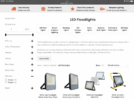True, but it certainly doesn't prove the manufacturers' lifespan figures either.
Indeed it doesn't. However, a lot of people seem to think that if they see a lot of fairly early failures, that means that a claim of, say, 10,000 or 15,000 hours 'average' lifespan "simply cannot be true" - but I've explained that such is not correct.
Personally, I'd be keen to see the LED manufacturers' documented justification for their average service life claims (I didn't realise LED lifespan was expressed as a median average, I assumed it was mean).
Medians are almost universally quoted in relation to life expectancy figures, in all fields. Means are really no better, in some senses worse, since just a small number of products with very long lives can make the claimed 'average' (mean) very over-optimistic. Medians are also more useful to large-scale users who want to know how many replacements to hold in stock.
Another problem, of course, is that claimed lifespans are necessarily only estimates, based on extrapolation and/or 'accelerated testing' - since if one wanted to 'properly test' lifespan of a new product with an expected life of, say, 15,000 hours, one would have to have to test a large batch for at least 15,000 hours (not far short of 2 years) before marketing the product (with a 'lifespan claim) - and the speed of advance of technology is such that the product might almost be ';obsolete' by then

It may well be that, under perfect usage and environmental conditions, 50%+ of the actual LEDs do last for 15000 hours (or whatever lifetime figure is advertised) but real life anecdotal evidence (albeit limited) suggests this isn't the case at the moment. A larger survey is needed!
I'm inclined to agree but, as I've implied, it's not simple. Having said that, as I've also said, my personal experiences of cheap indoor LEDs is that they seem to usually ask for a pretty long time - certainly 'years' in some cases.
Other factors may shorten the life of the LED, such as water ingress, large temperature variations (overheating), electrical supply spikes and the number of on/off switchings.
All true, But most of those factors are pretty 'intangible' and therefore difficult to take into account - either in tresting or use.
I think it's also possible that the LED driver fails before the LEDs themselves.
Very much so. In the cheapest ones, where 'the driver' just consists of a bridge rectifier and a couple of expereince, in terms of the dead ones I've dissected, it is nearly always one of the capacitors which fails. The LED elements might reduce in brighteness after long use, but generally don't themselves 'fail'.
To end on a positive note... My first experience of LED lamps came in the early days of mains LED lighting when I purchased two 2W corn-style lamps direct from China. Fitted them to my garage as external bulkhead lights and they both lasted 10+ years. The lamps were controlled by a photocell, not a PIR, and, averaged over a year, were lit for around 12 hours per day. I worked out that the service life of each exceeded 50,000 hours - so it can be done.
Yes, they can do well, even outdoors. I have a couple of PAR38 LEDs (I think probably 15W) in my garden which are on every day from dusk until about 11pm (combination of photocell and timeswitch). I'm not sure that I have ever had to replace either but, if I did, it was many years ago!
Kind Regards, John


